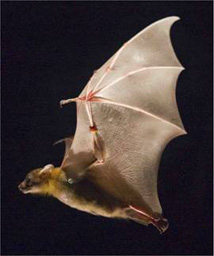FLIGHT
Of the many sophisticated aspects of a bat physiology, only one aspect sets Chiroptera apart from all other mammals - the ability to sustain flight. There are many factors involved in the evolution of the wing shape. Species preference for habitat, size and type of prey dictate the type of wing required for the job. As in the world of man made flight, there is not a perfect airfoil. Flying high requires a different type of wing compared to flying slow and lifting heavy objects from the earth! So it is with bats. If a bat is a migratory bat, it would prefer a wing with high aspect ratio wings, but their wing loading can be low, because they don’t need to fly fast. An example would be the silver-haired bat (Lasionycteris noctivagans). Bats flying within vegetation require slow speeds, but high manoeuvrability, and short wings.
In order to sustain flight, a bat must follow basic principles of aerodynamics. Lift must be greater than weight, and thrust must be greater than drag. There are various ways in which to make this work. Wing loading is determined by the weight it has to carry distributed by the area of the wing. Aspect ratio on the other hand is determined by dividing the wing span by its average width or chord.
In summary...
high aspect ratio wings provide:
high performance characteristics, fast flight, hovering ability, soaring capability
low aspect ratio wings provide:
lifting greater weight, efficient at lower speeds, more manoeuverable
Nearly all Frugivorous bats, and many insectivorous species have low aspect wings.
Molossid bats have the highest aspect wings, and they are often cited as the epitome of high performance flight (free tailed and mastiff bats)
The flight characteristics of bats in flight is being studied by Dr. Kenny Breuer and Dr. Sharon Swartz of Brown University, Rhode Island. Below is a part of their website. They have graciously permitted the use of some incredible video they have attained during their research. Thank you to Dr. Breuer and Dr. Swartz and Brown University for their contribution!
Bat Flight Research Program
Kenny Breuer, Division of Engineering
Sharon Swartz, Ecology and Evolutionary Biology
Although the natural world has countless examples of creatures with extraordinary flight capabilities, bats have evolved with truly extraordinary aerodynamic capabilities that enable them to fly in dense swarms, to avoid obstacles, and to fly with such agility that they can catch prey on the wing, maneuver through thick rainforests and make high speed 180 degree turns. Bats possess specialized features that may contribute to their flight performance, including highly articulated and flexible skeletons, flexible and compliant membrane wings, thousands of tiny hair sensors distributed over their wing surface as well as a series of muscles embedded in the wing membrane whose function appears to be the active control of camber during flight. Our multidisciplinary research team consists primarily of researchers from Biology and Engineering and includes significant collaborations with researchers in Computer Science and Applied Mathematics, all working to characterize these unique flight capabilities, to understand the roles that the bats' bones, skin morphology and wing motion all play in enabling this behavior, to model these mechanisms, and ultimately to emulate them in engineered systems.
Unlike insects and birds, both of whom have relatively rigid wings that can move with only a few degrees of freedom, the bat's wing is comprised of a thin, highly compliant skin membrane that is supported on a very flexible jointed skeleton with numerous degrees of freedom. The aerodynamics of flexible, articulated wings is extremely complex and poorly understood, and our team is studying their characteristics using high-speed measurements of the bat's wing and body motion. These kinematic measurements are synchronized with Particle Image Velocimetry (PIV) measurements of the fluid velocity in the wake behind the animal and, together, the kinematic and fluid measurements will shed light on the lift and thrust mechanisms that bats use during straight flight as well as maneuvers. In support of these biological flight experiments, we are performing wind tunnel tests on physical models that mimic features observed in nature, material tests on bat bones and wing membranes, numerical simulations, theoretical modelling and advanced scientific visualizations.

Lesser short-nosed fruit bat, Cynopterus brachyotis